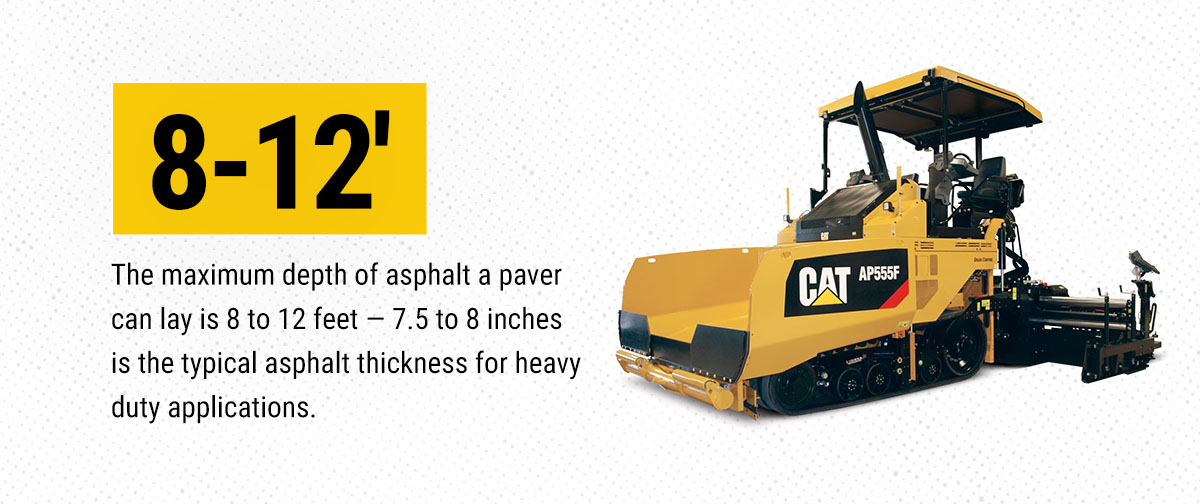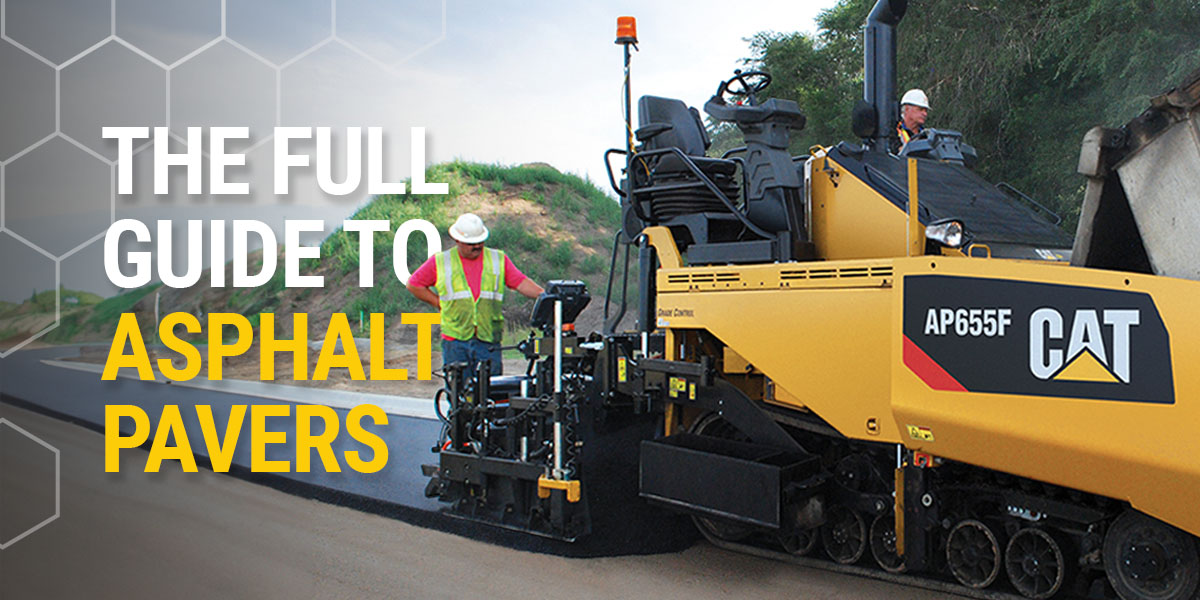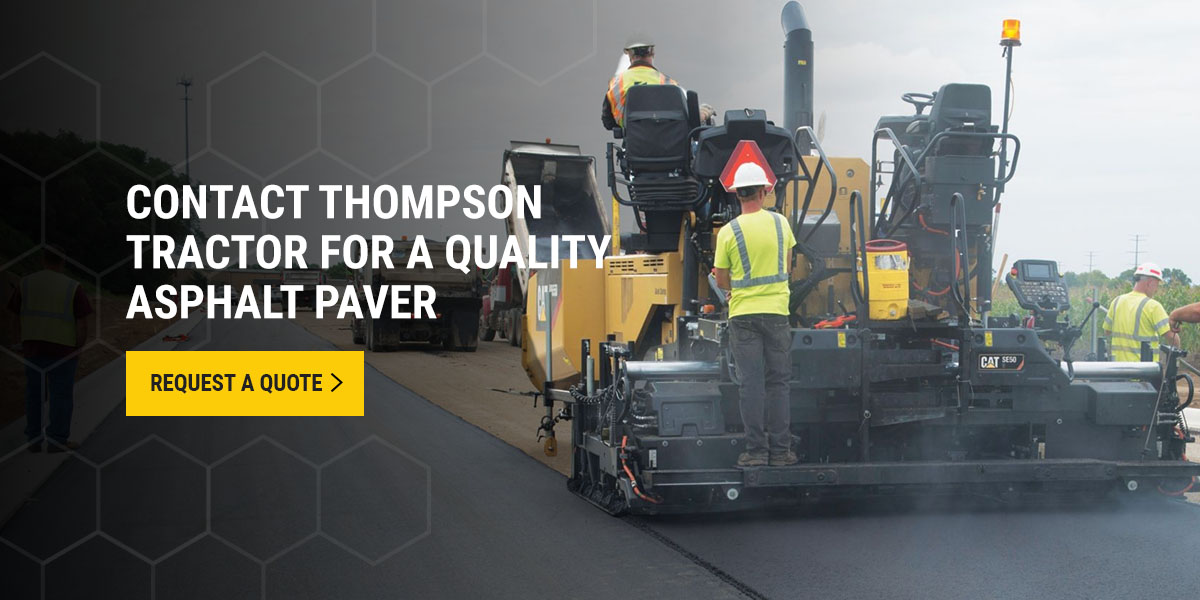An asphalt or road paver evenly distributes, compacts, and smooths asphalt. Understanding how a paver works, how to use a paver, and how to choose the right paver for a job can help you complete paving work efficiently.
What Is an Asphalt Paver?
An asphalt paving machine distributes and levels asphalt to transform rough terrain into smooth surfaces. It also uses a screed to compact the asphalt, reducing its volume.
In the past, large construction crews paved asphalt manually with shovels and picks. The development of the asphalt paver made road paving an easier and much faster process.
Asphalt Paver Types
Some asphalt pavers require a dump truck to tow them, but most models use tires or tracks to self-propel. Tracked and wheeled asphalt pavers contain two main components — the screed and the tractor. The screed shapes the asphalt while the tractor tows the screed. The ideal type of paver depends on ground coverage, work conditions, and the type of job you need to complete.
Consider the following asphalt paver types to choose the best option for your next job:
Tracked Paver
Tracked pavers are best for challenging work conditions and projects that require wide pulls. A tracked paver operates on rubber tracks, delivering optimal stability, maneuverability, and traction. Use a tracked paver if you plan to work with a full load or apply pavement to the following types of surfaces:
- Mud
- Clay
- Sand
- Hillsides
- Steep grades
Wheeled Paver
A wheeled paver operates best on flat, even surfaces. It’s more efficient than a tracked paver because it can quickly cover long distances. Wheeled pavers are ideal for these project conditions:
- Covering a large ground area
- Performing substantial relocation
- Distributing and smoothing asphalt across long stretches
- Performing work on existing asphalt surfaces
- Overlaying, filling, and milling applications
How Thick of a Layer Can an Asphalt Paver Lay?

Asphalt pavers can lay asphalt in various thicknesses. The maximum depth of asphalt a paver can lay is 8 to 12 feet — 7.5 to 8 inches is the typical asphalt thickness for heavy-duty applications.
How to Operate the Screed on an Asphalt Paver
An asphalt paver’s screed contains a system of vibrating extenders that level and compact asphalt after the paver deposits it on a surface. To operate a screed, it’s essential to understand the following parts:
- Screed plate: Operators flatten and compress asphalt using the screed plate.
- Screed heater: The screed heater maintains workable asphalt, preventing it from sticking and preventing the mat from tearing.
- Screed vibrator: A screed vibrator increases and maintains compaction quality.
- Depth crank: Operators use a depth crank to control mat thickness and screed angle.
An asphalt paver moves asphalt down a conveyor toward the back of the machine and onto an auger so the screed can distribute it. Several components work together so the screed can distribute asphalt.
Crown Placement
Some pavers have the crown on one end of the screed, while others have the crown in the center of the screed. A screed with a center crown allows crews to distribute and pave asphalt in one pass, which is often the most ideal option because it eliminates a cold joint. However, the following factors affect whether a cold joint or the absence of a cold joint is ideal:
- Road width
- Paver specifications
- Traffic maintenance
Manual vs. Automatic Screed Control
Manual grade manipulation occurs when a paver’s wheel path and elevation determine the asphalt’s smoothness. The screed arm’s “toe point” is where the arm attaches and how high its elevation is. When an operator performs manual grade operation, they use the toe point to affect the screed’s angle and mat thickness, controlling the asphalt’s grade. When performing manual grade manipulation, proper aggregate base placement is crucial.
Automatic screed control allows operators to control the tow point elevation using a control or reference separate from the tractor body. Outside controls or references are known as “automatic grade control” or “grade reference systems.” The most common modern automatic grade control systems are string line or lasers, mobile reference beams, and shoe joint references.
How to Adjust an Asphalt Paver’s Screed Using the String Line Automatic Grade Control System
Properly adjusting the screed is critical to achieving a horizontal, flat transverse after the machine compacts the asphalt. Adjust a screed with the following steps to ensure safety and optimal results:
- Raise the screed.
- Extend the service locks on both sides of the screed.
- Lower the screed and position the tow arms on the locks.
- Position the hydraulic tow point cylinders so the right and left cylinders are in the same position.
- Square the screed face with the tow arms at 90-degree angles using the depth control cranks.
- Retract the main screed’s trailing edge adjusters.
- Use a string line to ensure the screed is flat with zero crown — pull the string line across the main screed’s width and approximately 1 inch behind the screed plate’s leading edge.
- Place two equally-sized spacers between the screed plate and string line.
- Ensure the gap between the string line and screed plate is accurate using a third spacer.
- Set the string line across the main screed’s width and approximately 1 inch behind its nose bar.
- Place two equally-sized spacers between the screed plate and string line, ensuring it extends 1 inch from the screed plate’s end.
- Check the gap between the string line and the center of the screed plate using a third spacer.
- Place the string line across the main screed trailing edge’s width approximately 1 inch from the tail.
- Place the same spacers under the screed’s outboard edge adjusters, and use the third spacer to ensure the plate on each adjuster has the correct gap.
- Turn the adjusters to bring the screed to a flat position so the space between the screed plate and strong line is the same.
- Check the relationship of the screed plate to the screed extenders.
- Retract the trailing edge adjusters, and flatten the extender’s trailing edge.
How Expensive Are Asphalt Pavers?
An asphalt paver’s cost depends on the brand, size, condition, and whether you choose to lease or pay upfront. New pavers can cost between $170,000 and $750,000, and used pavers can cost between $150,000 and $400,000. Purchasing a paver allows you to own a brand-new machine that you can use for the long term, and renting allows you to take advantage of new machines without making large investments.
Contact Thompson Tractor for a Quality Asphalt Paver
Asphalt pavers are incredibly valuable machines offering fantastic capabilities. Thompson Tractor offers high-quality asphalt pavers to help you accomplish the toughest paving jobs efficiently. Whether you purchase an asphalt paver or rent one, you can trust Thompson Tractor to provide reliable equipment. Contact us to request a quote and learn more.



